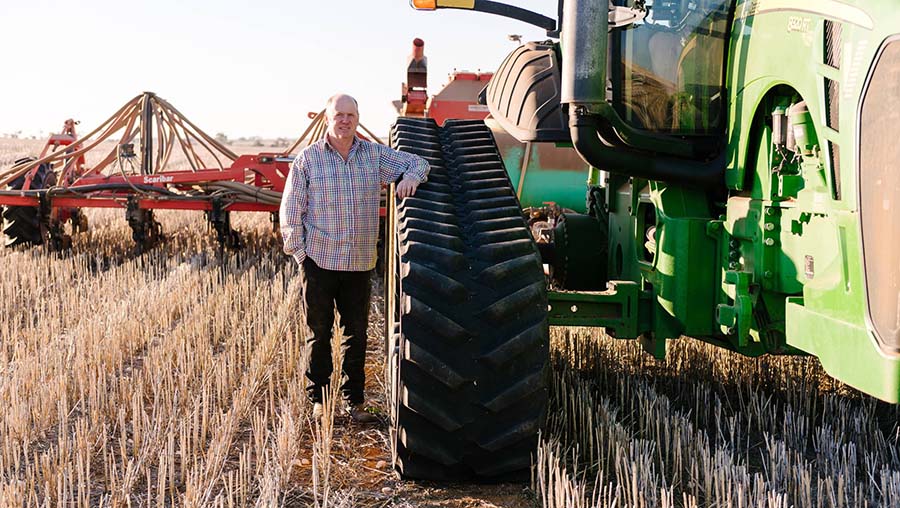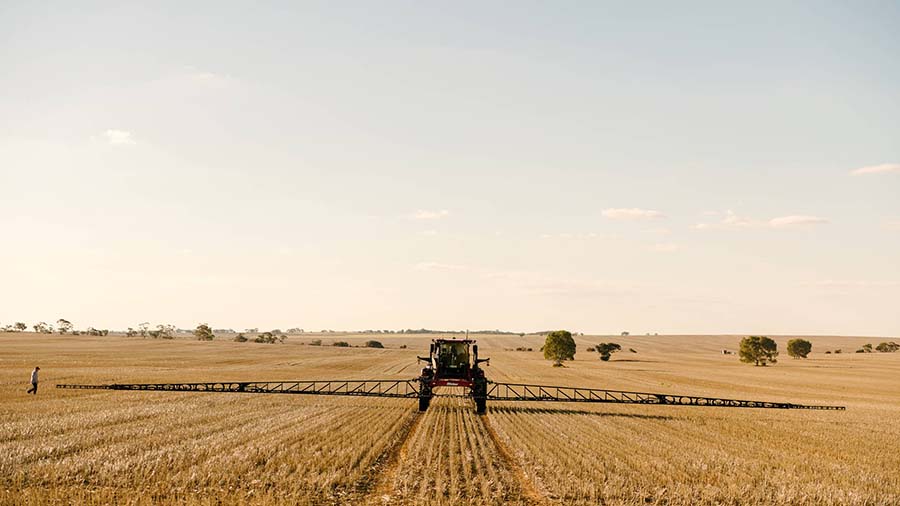Snapshot
- Grower: Gene Fuller
- Property name: 'Ochre Farms'
- Location: Yaapeet, Victoria
- Size: 3000 hectares
- Soil types: From very sandy to loamy and heavy
- Soil pH: 7.5 to 8
- Average rainfall: 250 millimetres (growing season) and 300mm (annual)
- Enterprise: Continuous cropping for the past five years
- Crops: A legume/cereal/canola rotation using lentils and lupins (on the lighter soils), wheat and barley.
In the Mallee's low-rainfall zone, growers were still waiting for a decent autumn break at the start of May.
April rainfall - which was forecast to be the state's best for the previous six months - disappointed, delivering just 10 millimetres at Yaapeet in Victoria, 134 kilometres north of Horsham.
It highlights the centrality of water as the key production constraint in the area, says Gene Fuller, whose 3000 hectares at 'Ochre Farms' is dedicated entirely to cropping legumes, cereals and canola.
In the previous season, he made do with just 100mm of rainfall until thunderstorms dumped an additional 100mm over two sodden days in December.
A run of unusually dry seasons on top of increasingly erratic rainfall patterns means that Gene wants his soils to absorb and retain every last drop of moisture possible.
The adoption of no-till farming practices went some way to achieving that goal.
He then followed up by adopting the practice best suited to supercharging his soil's water retaining capability: controlled-traffic farming (CTF).
CTF involves driving all machinery on permanent wheel tracks by matching all axles to a single track width and making all machines work in multiples of that width.
The goal is to reduce the paddock area compacted by machinery from 40 to 70 per cent to 10 to 15 per cent to improve the soil's air-filled porosity, allowing it to behave like a sponge.
"That has been the obvious impact from shifting to CTF," Gene says.
"I can see the rainfall is being better absorbed and retained. The water is not pooling or running off my paddocks. So with CTF, for me, it's about making the most of limited rainfall.
“I understand why people talk about CTF in terms of 'moisture farming'."
Shortages of spring rainfall in particular have been an issue in recent seasons, with Gene increasingly relying on moisture stored in his soils during winter.
It's these kinds of scenarios where CTF provides an advantage, Gene says.
Converting to CTF

Aligned axles on Gene Fuller's farm machinery help prevent soil compaction and promote soil moisture absorption and retention. Photo: Jim Aldersey
The purchase of a 27-metre-wide self-propelled sprayer with 3m wheel tracks in 2010 was the catalyst for the switch over to CTF at 'Ochre Farms'.
Gene says it matched his air seeder (at 13.5m) and that's when he started the conversion to CTF.
He has matched the remaining equipment, over time, rather than making dedicated investments.
He is now one chaser bin away from all his wheel tracks being fully aligned.
His machinery comprises the 27m sprayer and spreader combined with a 13.5 m header and seeder.
Gene modified his 320HP sowing and spreading tractors himself, using cotton reel extensions to convert the front wheel axles to 3m widths.
He did not find the process particularly challenging or costly, saying that all the information he needed was readily available on the internet.
The inspiration came from a fellow farmer he met at a field day.
"The fellow I met farmed to the south, where the soils are better," Gene says.
"He told me that CTF had made more of a difference to productivity than no-till.
"I figured if CTF worked for him, it would work for everyone."
However, when researching CTF, he noticed that advice can vary as to the key piece of machinery to use as the basis for CTF adoption.
While headers figure prominently in such discussions, Gene says he started with what he had on hand, which happened to be the sprayer.
"On my farm, it is the sprayer that does most of the damage, as it is on the paddocks six to eight times a year," he says.
"And I think it makes sense to worry about the machinery that is on the paddock the most."
Benefits and challenges
Gene says he is aware that CTF in higher-rainfall zones delivers many additional benefits. He says these include:
- Better soil health
- Lower fuel costs (due to reduced rolling resistance)
- Reduced fertiliser application rates
- Higher yields.
He believes he gains from additional benefits - such as improved inter-row sowing accuracy.
However, he has not quantified these because he would persist with CTF regardless, due to the soil's improved water retention.
With regards to upkeep, he says his permanent wheel tracks can erode and form ruts.
To counter this, Gene has made it a practice to sow into the tracks as a way of repairing them and preventing erosion.

Moisture farming in the Mallee. Photo: Jim Aldersey
As to the experience of being a CTF early adopter in his district, he compares it to the early days of no-till.
“It took a while for no-till to find acceptance,” he says.
“CTF adoption is likely to be similar.”
"The main hurdle is matching machinery.
"But if you allow the normal flow of machinery replacement to dictate the pace, then you can do it gradually without any extra expenditure."
Gene's advice to other growers?
“Pick the most suitable axle width and build up from there,” he says.
After all, he says: “Rome wasn’t built in a day”.
More information: Gene Fuller, 0427 957 323, intown38@bigpond.com

























































